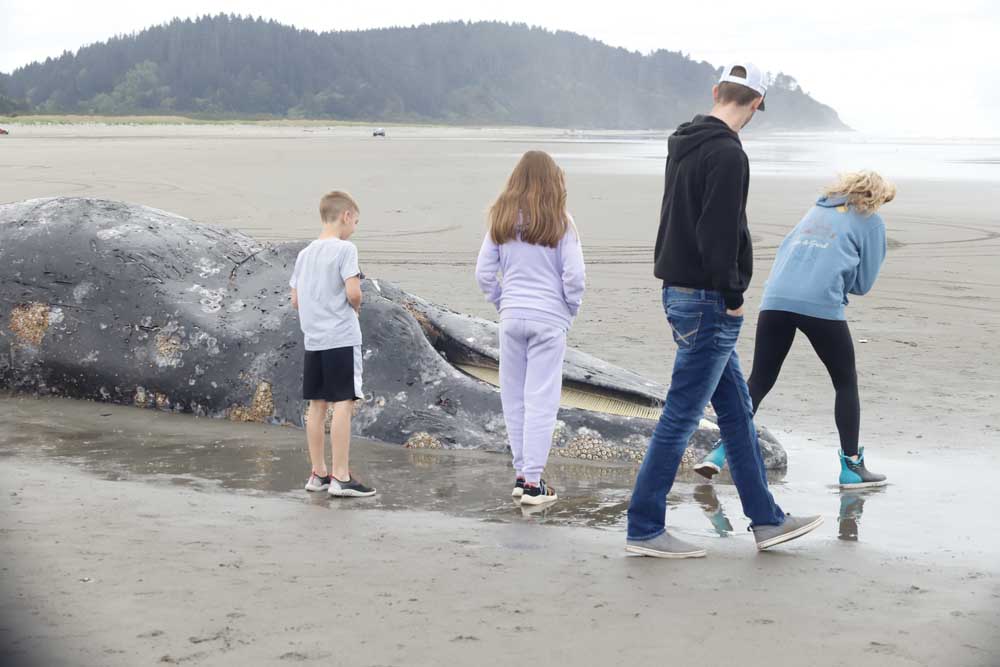Deceased whale washes up in Seaview
Published 11:02 pm Monday, May 6, 2024

- Onlookers observe a deceased 40-foot gray whale near Seaview on May 1. Like most whales that come ashore, the body was examined by experts to reveal clues about its life and death.
SEAVIEW — A deceased 40-foot gray whale washed ashore near the Seaview beach approach last week, first reported by passersby a few hundred yards south of the approach during the early-morning hours on Tuesday, April 30.
Trending
The whale was necropsied on Thursday, May 2, led by Portland State University along with members of Cascadia Research Collective, SR3 (Sealife Response, Rehab and Research), Washington Department of Fish and Wildlife and Seaside Aquarium.
“The whale was an adult male that washed in Seaview the evening of April 30,” said Portland State University Research Assistant Dalin D’Alessandro. “The primary finding was emaciation. There are some tissue samples pending further analysis to determine if an underlying illness was present.”
Gray whale mortalities down
There have been two other deceased gray whales that have washed ashore in Washington this year, including a 39-foot male on Vashon Island on April 12 and a 42-foot male near Ocean City on April 10, according to the Cascade Research Collective (CRC). An entangled gray whale was also reported in Grays Harbor on April 16, however the research team was unable to locate the animal and are awaiting further sightings.
Fortunately, gray whale mortalities have declined since peaking in 2019, and scientists are hopeful that we will return to baseline levels this year, according to CRC. Gray whale strandings in Washington typically occur between April and June, when the majority of the gray whale population passes by as they migrate to feeding grounds in the Bering Sea.
To report marine mammal strandings anywhere on the West Coast, please call the West Coast Stranding Hotline at 1-866-767-6114 to be connected to your local response organization. Please report live entangled whales to 1-87-SOS-WHALE.
Size and appearance
Adult gray whales can grow to 49 feet and up to about 90,000 pounds, according to NOAA.
Gray whales have a mottled gray body with small eyes located just above the corners of the mouth. Their pectoral flippers are broad, paddle-shaped and pointed at the tips. Lacking a dorsal fin, they instead have a dorsal hump about two-thirds of the way back on the body, and a series of 6-12 small bumps, called “knuckles,” between the dorsal hump and the tail flukes. The tail flukes are nearly 10 feet wide with S-shaped trailing edges and a deep median notch.
Calves are typically born dark gray and lighten as they age to brownish-gray or light gray. All gray whales are mottled with lighter patches. They have barnacles and whale lice (i.e., cyamids) on their bodies, with higher concentrations found on the head and tail.
Behavior and diet
Gray whales are frequently observed traveling alone or in small, mostly unstable groups, although large aggregations may be seen in feeding and breeding grounds. Like other baleen whales, long-term bonds between individuals are thought to be rare.
They are primarily bottom feeders that consume a wide range of benthic (sea floor) and epibenthic (above the sea floor) invertebrates, such as amphipods. Gray whales suck sediment and food from the sea floor by rolling on their sides and swimming slowly along, filtering their food through 130-180 coarse baleen plates on each side of their upper jaw. In doing so, they often leave long trails of mud behind them and “feeding pits” on the seafloor.
Range
Gray whales are found mainly in shallow coastal waters in the north Pacific Ocean, although during migration they do sometimes cross deep waters far from shore.
Lifespan
Gray whales become sexually mature between 6 and 12 years, with the average maturity being about 8-9 years old. After 12 to 13 months of gestation, females give birth to a single calf. Newborn calves are approximately 14-16 feet long and weigh about 2,000 pounds. The average and maximum lifespan of gray whales is unknown, although one female was estimated at 75-80 years old after death.
About the species
Once common throughout the Northern Hemisphere, gray whales are now only regularly found in the north Pacific Ocean where there are two extant populations, one in the eastern and one in the western north Pacific, according to NOAA.
Gray whales earned the nickname “devil fish” because of their aggressive reactions when harpooned. Commercial whaling rapidly brought both Pacific populations to near extinction. International conservation measures were enacted in the 1930s and 1940s to protect whales from over-exploitation, and in the mid-1980s the International Whaling Commission instituted a moratorium on commercial whaling.
Gray whales are known for their curiosity toward boats in some locations and are the focus of whale watching and ecotourism along the west coast of North America. Gray whales make one of the longest annual migrations of any mammal, traveling about 10,000 miles round-trip and in some cases upwards of 14,000 miles. On their migration routes they face threats from vessel strikes, entanglement in fishing gear and other sources of disturbance.








